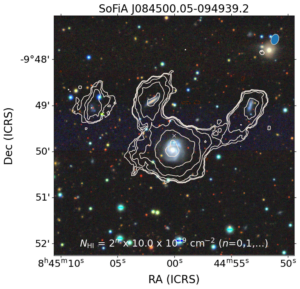
Dr. Marcin Glowacki, from the Curtin University node of the International Centre for Radio Astronomy Research (ICRAR) in Western Australia, led the research, which aimed to study the star-forming gas in a single radio galaxy.
Although the team didn’t find any star-forming gas in the galaxy they were studying, Dr. Glowacki instead discovered other galaxies while inspecting the data.
In total, the gas of 49 galaxies was detected. Dr Glowacki said this was a great example of how fantastic an instrument like MeerKAT is for finding the star-forming gas in galaxies.
“I did not expect to find almost fifty new galaxies in such a short time,” he said.
“By implementing different techniques for finding galaxies, which are used for other MeerKAT surveys, we were able to detect all of these galaxies and reveal their gas content.”
The new galaxies have been informally nicknamed the 49ers — a reference to the 1849 California gold rush miners.
Dr Glowacki views the 49 new galaxies as valuable as gold nuggets in our night sky.
Many galaxies are near each other, forming galaxy groups, with several identified in one observation.
Three galaxies, in particular, are directly connected by their gas.
Dr Glowacki said, “These three are particularly interesting, as by studying the galaxies at other wavelengths of light, we discovered the central galaxy is forming many stars. It is likely stealing the gas from its companion galaxies to fuel its star formation, which may lead the other two to become inactive.”
Professor Ed Elson, from the University of the Western Cape and a co-author of the paper, said, “This discovery highlights the raw power of the MeerKAT telescope as an imaging instrument. The methods we developed and implemented to study the 49ers will be useful for MeerKAT large science surveys, and smaller observing campaigns such as ours.”
The discovery was no accident. Recently, an ICRAR summer student, Jasmine White, working with Dr Glowacki, helped find even more gas-rich galaxies in other short observations made by MeerKAT.
“We hope to continue our studies and share even more discoveries of new gas-rich galaxies with the wider community soon,” Dr Glowacki said. https://www.icrar.org/49galaxies/









Recent Comments